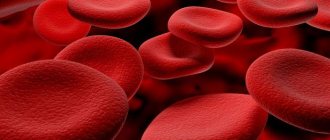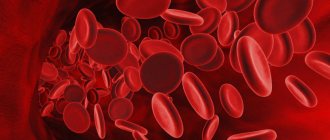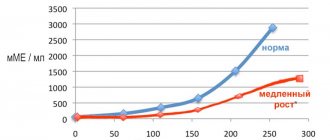Let's consider the situation when fibrinogen is higher than normal: what it means and how to treat it. According to the international nomenclature, fibrinogen is the first factor of the blood coagulation system, synthesized by liver cells (hepatocytes). According to its chemical structure, it is a colorless protein soluble in blood plasma. Fibrinogen analysis allows you to diagnose hereditary pathologies associated with disruption of the formation of blood clots, as well as liver diseases and infectious inflammation.
What is fibrinogen in a blood test?
After synthesis, the coagulation protein molecule enters the bloodstream, where it takes part in the formation of a thrombus (clot) when a vessel or tissue cells are damaged. The clot prevents further bleeding. After launching a cascade of biochemical reactions, fibrinopeptide A and B are first cleaved from the fibrinogen molecule, which are converted into fibrin monomer, followed by polymerization into protein strands. Fibrin threads form an interwoven mesh - the basis for clot formation.
An analysis to determine the level of fibrinogen in blood serum is prescribed to patients when:
- the need for surgical intervention to assess the likelihood of bleeding or thrombosis;
- inflammatory diseases;
- prenatal diagnostics;
- high risk of thrombosis;
- hereditary coagulopathies;
- kidney disease;
- treatment with anticoagulants and angioplatelet agents;
- selection of therapy for chronic pathologies of the liver and cardiovascular system.
Fibrinogen - what is it?
One of the protective functions of the body is the process of blood clotting. After an injury occurs, blood clots begin to form in the blood vessels, blocking the blood flow. This reduces the risk of large blood loss.
Normally, fibrinogen is a colorless protein in blood cells. Due to injury, under the influence of enzymes it is converted into fibrin. As a result, thin connecting threads appear, which promote fermentation and the accumulation of blood clots. Thus, the level of fibrinogen is directly related to the erythrocyte sedimentation rate (ESR).
During pregnancy, a woman's body experiences a strong hormonal surge and a restructuring of many processes. Including thrombus formation. As a result of childbirth, the mother loses a large amount of blood. When the placenta separates, a wound remains on the surface of the uterus, which should heal quickly.
That is why the fibrinogen level in pregnant women is usually higher than in other women and men. However, a significant increase is also dangerous, as it can cause thrombosis. Excessive blood clotting in later stages can lead to gestosis.
The normal level of fibrinogen in the blood of women, men and children
Important: it is unacceptable to try to decipher test results on your own to choose treatment. This can lead to complications in the severity of the disease and the patient himself.
Only a specialist can interpret the data obtained from a blood test for fibrinogen in combination with other laboratory parameters and the patient’s medical history.
The norm of fibrinogen in a biochemical analysis of blood serum ranges from 1.8 to 4 g/l. It should be noted that the minimum level of fibrinogen in the blood is 0.5 g/l - only in this case is it possible to maintain homeostasis in the human body.
Normal (reference) values are the same for both sexes and all ages. The exception is pregnant women.
Fibrinogen levels during pregnancy by trimester
Normally, fibrinogen increases significantly during pregnancy. This is due to the need to prepare a woman’s body for childbirth, during which blood loss is inevitable. During a physiological birth, the expectant mother loses about 300 ml of blood, and during a caesarean section this figure reaches 750 ml. In order to prevent excessive bleeding, the blood coagulation system is activated.
When interpreting the obtained data, it is necessary to take into account the gestational age, since the reference values for them are different. The table shows the maximum permissible indicators of the criterion under consideration.
| Gestation period, weeks | Normal values, g/l |
| 1 – 14 | 2,2 – 4,35 |
| 14 –20 | 2,85 – 5,28 |
| 210 – 30 | 3,1 – 5,68 |
| 30 – 35 | 3,1 – 5,73 |
| 35 – 42 | 3,3 – 6,2 |
The maximum increase in fibrinogen is typical for the third trimester during pregnancy, since the woman’s body activates all systems and organs in preparation for labor.
Read further: What should everyone know about biochemical blood tests?!
What to do if fibrinogen levels change
Treatment for changes in fibrinogen concentration consists of relieving the causes that led to this, namely:
- Anti-inflammatory and antibacterial therapy of infectious diseases.
- Hepatoprotectors (drugs that restore liver cells) for liver diseases.
- Medical or surgical restoration of necrotic tissue in case of burns or heart attacks.
- Surgical removal, chemotherapy of tumors and blood diseases.
- Correction of hypothyroidism by prescribing thyroid hormones.
- Stop taking anabolic hormones or estrogens.
- Intensive detoxification in case of poisoning for the prevention of DIC syndrome.
- Consuming sufficient daily amounts of vitamin C (50–100 mg) and B12 (2–5 mcg).
- Prompt administration of anti-snake serum after a snake bite.
It must be remembered that changes in fibrinogen levels are a laboratory symptom. A blood test for fibrinogen will reveal abnormalities. If this indicator changes, a comprehensive additional examination is necessary to determine the diseases that led to this. Lack of adequate treatment can lead to severe internal and external bleeding when it decreases, or to increased thrombus formation when its concentration is high.
Fibrinogen is higher than normal - what does this mean in an adult?
The first coagulation factor is classified as a protein in the acute phase of inflammation. Therefore, high fibrinogen in the blood is recorded during an infectious lesion of the human body, as well as during tissue destruction. A one-time deviation from the norm can be caused by physiological reasons or improper preparation of the patient for the delivery of biomaterial. The disadvantage of the method is a wide range of possible pathologies in which the level of fibrinogen in the blood serum exceeds the norm.
In addition to the inflammatory process, fibrinogen above normal is observed with:
- the presence of malignant neoplasms with metastases;
- extensive burns;
- insufficient synthesis of thyroid hormones;
- viral or bacterial infection - influenza, tuberculosis, pneumonia;
- heart pathologies (heart attack, stroke);
- taking medications based on female sex hormones, including oral contraceptives;
- amyloidosis – disruptions in the processes of protein metabolism, as a result of which a protein-polysaccharide complex is deposited in the tissues.
If fibrinogen is increased during pregnancy
Patients are often interested in the question: why control fibrinogen during pregnancy? Testing for protein blood clotting factors is mandatory for every woman upon registration and throughout pregnancy. This fact is due to the fact that exceeding normal values in a pregnant woman may indicate the development of a pathological process.
High fibrinogen in pregnant women can cause miscarriage or premature birth as a result of blockage of the umbilical cord artery by a blood clot, which leads to placental abruption. In this case, the woman is placed under 24-hour medical supervision and corrective therapy is prescribed.
Fibrinogen is below normal, what does this mean?
Fibrinogen below normal is noticed during menstruation, but may indicate the following diseases:
- disseminated intravascular coagulation in particular,
- in pregnant women with placental abruption,
- rapid childbirth, etc.);
- meningococcal meningitis;
- prostate cancer with metastases;
- leukemia;
- liver failure (acute and chronic);
- congenital fibrinogen deficiency (fibrinogenopenia).
The indicator value is below normal
A deviation of the criterion downward from normal indicators is no less important diagnostic value than an increase. Fibrinogen is low - what does this mean?
Before identifying the causes of the decline, it is necessary to exclude factors that do not relate to pathological conditions. Thus, protein may be reduced as a result of a recent blood transfusion from a donor to a recipient, as well as as a result of taking steroid or sedative medications.
Pathological conditions that reduce fibrinogen levels:
- DIC syndrome is a disruption in the implementation of blood clotting mechanisms, which is the result of an excessive release of thromboplastic molecules from damaged tissues. Observed in conditions of shock, extensive trauma, bacterial or viral sepsis, as well as complications during childbirth;
- chronic liver diseases – cirrhosis, hepatitis;
- hypofunction of vitamins C B12;
- the entry of amniotic fluid into the mother’s bloodstream, which leads to the development of shock, even death;
- chronic myeloid leukemia is a malignant lesion of the hematopoietic system;
- Vaquez disease is a benign pathology that leads to an excess of red and white blood cells;
- intoxication with snake venoms.
What are the dangers of fibrinogen deviations from the norm?
High values indicate thick blood, which significantly increases the risk of blood clots forming to clog blood vessels. In addition, a deviation from the norm indicates the development of a pathological process in the patient’s body. In most cases, this is an infectious disease or tissue destruction. Conditions require clarification of the diagnosis; for this, the patient is prescribed additional examination methods, which include:
- determination of activated partial thromboplastin time (aPTT);
- antithrombin test;
- coagulogram with the obligatory establishment of prothrombin time and international normalized ratio.
A lack of protein leads to disruption of the blood clotting system, which can lead to extensive bleeding. Therefore, analysis is mandatory in preparation for surgery and during pregnancy.
Read further: Blood coagulogram analysis - norms, deviations, therapy
Fibrinogen during pregnancy
In women, fibrinogen concentrations during pregnancy are significantly higher than normal concentrations, especially in the last trimester. It is worth noting that an increased level of FG in the blood can negatively affect the course of pregnancy. If a given protein is analyzed much higher than the reference values, this means that the risk of blood clots is very high.
In this case, blood clots can form in the blood vessels of the placenta, blocking them and limiting the flow of oxygen to the baby. This situation can cause a lack of oxygen in the fetus (hypoxia), which will consequently lead to retardation in physical development or even death.
If fibrinogen in women during pregnancy is below reference values, this may indicate an increased risk of bleeding, which can lead to early placental abruption and death. According to statistics, the incidence of death with placental abruption with accompanying bleeding is much higher than with any other pathology.
Preparing and conducting analysis
The biomaterial for the study is serum obtained after centrifugation of venous blood taken from the patient’s elbow. The study can be completed in private and public clinics. Protein levels are determined using side-scatter detection with endpoint percentage determination. The period for obtaining results does not exceed 1 day, not counting the day the biomaterial is submitted.
The accuracy of the data obtained depends not only on the correctness of the analysis, but also on whether the patient was prepared for the test or not. The most reliable results are obtained if:
- blood is donated after an 8-12 hour overnight fast, you are allowed to drink unsweetened water without gas;
- for 1 day, spicy, fatty and smoked foods, as well as alcohol, are excluded from the diet;
- physical and emotional stress is limited within 1 hour, it is advisable to cancel sports training on the eve of submitting the biomaterial;
- By agreement with the doctor, taking medications is canceled 2-3 days in advance. If it is impossible to cancel, you should notify the laboratory employee about the medications you are taking.
- smoking is prohibited 30 minutes before;
How to reduce fibrinogen in the blood?
Consistently high analysis rates indicate the need to select treatment methods. First of all, it is necessary to identify the cause of the deviation from the norm. In case of an infectious disease, drugs are prescribed to eliminate it. After successful treatment, the value of the value in question automatically returns to normal limits.
The chronic condition of elevated protein requires the use of medications whose action is aimed at thinning the blood, for example, heparin.
In a critical condition, the patient may be prescribed fibrinolytics - drugs that destroy the fibrinogen molecule. Their use is limited due to the high risk of bleeding, the frequency of which increases in elderly patients.
The patient is given a special corrective diet. It is recommended to exclude foods high in cholesterol and animal fat from the diet. Prescribing vitamin complexes also helps maintain normal levels. If there is a lack of thyroid hormones, it is necessary to use drugs that correct this condition. Patients should avoid severe physical and emotional stress.
FG is overestimated
It is important to note that since FG functions as one of the proteins in the acute phase of inflammatory processes, it may be higher than the reference values for inflammation and tissue damage. A blood test for FG is not specific, that is, using only one test result it is impossible to make a correct diagnosis and prescribe treatment. In this case, it is necessary to conduct a complex of studies, which should include all coagulogram tests, as well as analysis of all components of rheumatic tests.
A condition in which fibrinogen levels are significantly higher than normal values is called “hyperfibrinogenemia.” Among its reasons it is worth highlighting:
- formation of malignant tumors;
- myocardial infarction (a form of coronary heart disease);
- extensive burns;
- surgical intervention;
- acute infectious and inflammatory diseases;
- stroke;
- amyloidosis (one of the forms of protein metabolism disorders);
- pneumonia (pneumonia);
- use of female hormones (estrogens) or oral contraceptives.
It is worth noting that hyperfibrinogenemia cannot indicate the location of tumor, inflammatory or infectious diseases. To determine the location of the lesion, additional tests must be performed.
It is important that fibrinogen levels above reference values may indicate an increased risk of thrombosis, as well as cardiovascular disease.
To lower the level of FG in the blood, doctors usually prescribe: anticoagulants (heparin, fraxiparin), fibrinolytics (streptokinase, pharmacokinase), antiplatelet agents (aspirin, cardiomagnyl). It can also be recommended to review the diet, excluding animal fats and cholesterol, and additionally take vitamin complexes and microelements. Such therapeutic tactics will effectively reduce the content of FG, and therefore reduce the risk of developing thrombosis.










